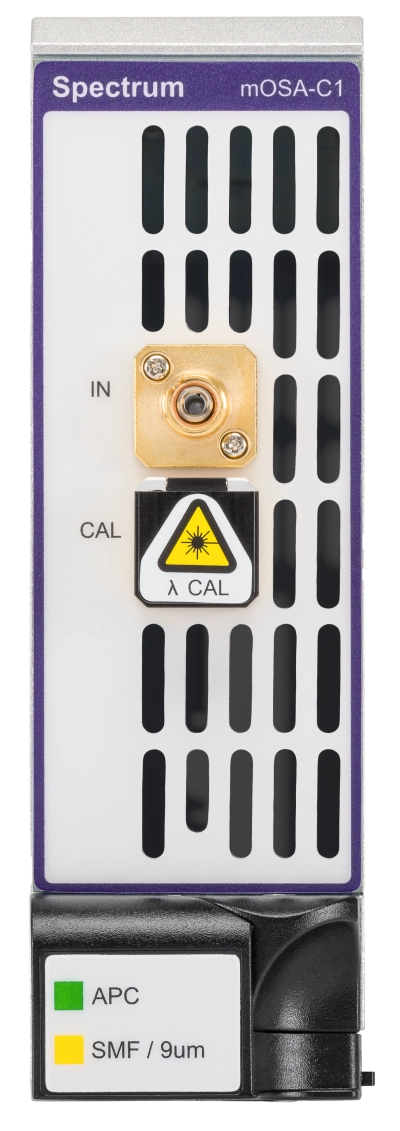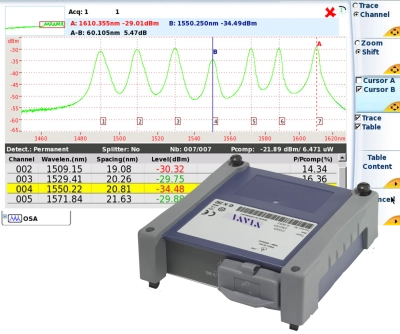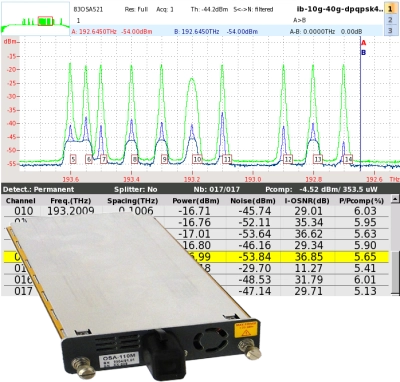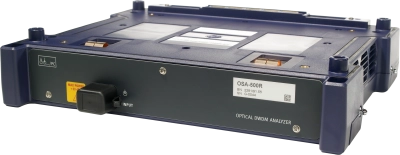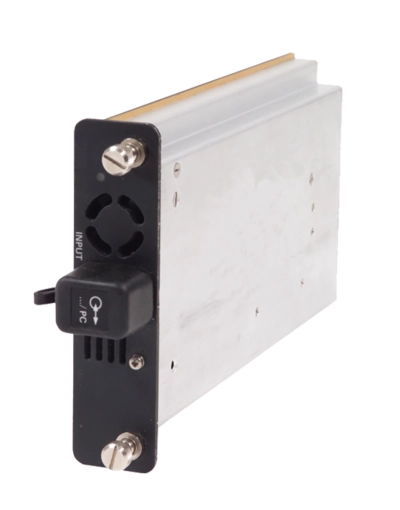Optical Spectrum Analyzers (OSA)
VIAVI covers a broad range of OSA needs with many compact solutions.
Optical Spectrum Analyzers (OSA) from VIAVI
An optical spectrum analyzer extends the principles of spectrum analysis to the optical realm by measuring important wavelength, power, and noise characteristics of light waves. As fiber optic networks and laser applications have expanded, optical test solutions and practices have evolved to keep pace with dense wave division multiplexing, tightened channel spacing, and a host of new optical sources and transmission protocols.
VIAVI has developed an industry-leading portfolio of optical spectrum analysis test solutions for lab, field, and manufacturing applications. This includes comprehensive test coverage for long haul, access network, and data center interconnect fiber links with high channel counts, strict signal to noise requirements, and coherent technology enabling high speed transmission. Development and production of optical systems and components is supported by compact full-band OSA modules with lab grade performance and resolution.
What is an Optical Spectrum Analyzer?
An optical spectrum analyzer (OSA) quantifies and displays the power of an optical light source over a given wavelength range. Much like an RF spectrum analyzer, the OSA displays the power in the y (vertical) axis and the wavelength in the x (horizontal) axis. Three key parameters that are measured by an optical spectrum analyzer are the wavelength, power level, and optical signal-to-noise ratio (OSNR).
A fiber optic communication network utilizing wavelength division multiplexing (WDM) to allow multiple optical carrier signals to be carried over a single fiber is an ideal application for the OSA spectrum analyzer. Long haul networks with inline amplification rely on accurate optical power and OSNR measurements to ensure optimal performance. While some optical spectrum analyzers are tailored to specific wavelength bands (C, L, O-band, etc.), others can operate effectively across multiple bands. Spectrum analyzer optical testing also enables transmissivity and reflectivity testing of optical components at specific wavelengths, and amplifier noise testing.
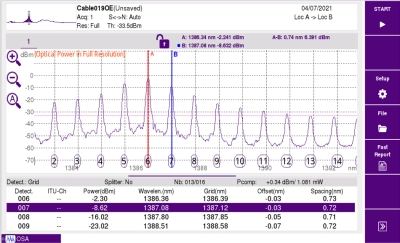
Optical Spectrum Analysis Use Cases
Fiber optic networks utilize light pulses to convey digital information over thousands of kilometers. High speed data transmission and WDM technology are now part of fiber networks such as CATV HFC/DAA, 5G x-haul, and hyperscale data center interconnects. Test solutions in the field must be capable of wavelength selective measurement to capture the key parameters for individual channels/services. As the accuracy, resolution, and usability of optical spectrum analyzers improves, new opportunities arise for world class product development and efficient production testing of optical systems and components.
The optical spectrum analyzer is commonly used in R&D labs worldwide, as next generation laser, LED, WDM, and transponder innovations push the limits of optical technology. As these components are integrated into new systems and manufactured at scale, accurate and reliable production scanning in milliseconds keeps pace with demand.
-
High-Resolution Spectral Measurement capabilities enable deeper analysis of modulated DWDM transmitters in both lab and manufacturing environments. The VIAVI mHROSA module provides sub-GHz wavelength resolution, in the extended C-band and gives manufacturers visibility into the fine spectral features resulting by single and multi-carrier coherent modulation formats as well as enable modulator tuning and validation of OSNR.
-
Volume Manufacturing of modules, passive components, lasers, and amplifiers requires a fast and flexible spectrum analyzer working over the entire single mode wavelength range (1250nm to 1655nm). Key measurements like channel power, bandwidth, noise power and OSNR. The VIAVI MAP Wideband OSA (mOSA-C1) delivers unmatched test speed and simplicity in an ultra-compact plug-in module.
The complexity of today’s fiber networks would not be sustainable without advanced spectrum analyzer optical solutions. Wavelength and power measurements must be performed throughout the network lifecycle. For high speed fiber networks with inline amplification and reconfigurable optical add-drop multiplexers (ROADM), the optical signal to noise ratio is used to assess performance of an optical network link.
- CWDM Testing: Fiber networks utilizing coarse wave division multiplexing (CWDM) with channel spacing at 20nm benefit from compact, full-featured OSA solutions. Analyzer features for access network testing in this category should include wavelength flexibility from 1250nm to 1650nm, ≥18 channel capacity, and a power measurement range typically from -50dBm to +10dBM, occasionally up to +25dBm to support higher power CATV applications. A portable optical channel checker (OCC), which only performs power and wavelength measurements, can also be a viable and economical solution as CWDM links are not amplified (typically) and so do not require OSNR testing.
- DWDM System Testing: Once limited to long haul (>100km) deployments, dense wave division multiplexing (DWDM) with channel spacing below 0.8 or 0.4nm and utilizing the C-band is now being used for access networks and data centers. ROADM technology makes OSNR measurement essential for installation, optimization, and maintenance of network links and service performance.

- Line Side 100G Testing: 100G networks with inline ROADM present unique challenges for spectral testing. Although the installation, maintenance, and troubleshooting processes are like legacy 10G networks, new coherent modulation formats have introduced new challenges. An advanced optical spectrum analyzer (OSCA-710) capable of measuring wavelength, power, and in-band/in-service OSNR, by utilizing a spectral correlation technique, for each DWDM channel from an amplifier test access point is recommended to characterize coherent 100G networks accurately without disrupting services to customers.

How Does an Optical Spectrum Analyzer Work?
To apply the spectrum analysis principles originally developed for radio to light waves, it is important to consider the behavior of light as a closely related form of electromagnetic radiation. An Optical Spectrum Analyzer must be able to select a specific wavelength for measurement, then a photodetector can be used to convert light energy into measurable electrical energy (power). There are different technologies that can be used to select individual wavelengths for measurement.
- Diffraction Grating (Monochromator)
To determine the power for an individual wavelength, the diffraction grating method uses a rotating filter or “grating” inside the optical spectrum analyzer. As the grating in the monochromator moves different wavelengths are presented to the photodetector sequentially as the grating rotates. This method is known for accommodating a wide spectral range and producing accurate readings. The sensitive moving parts in this type of device make it important to protect the OSA from drops or other types of shock. - Fabry-Perot Method
The Fabry-Perot interferometer method filters incoming light using parallel mirrors to create a resonant cavity. To set the input wavelength, the spacing between the mirrors is tuned using piezo elements. The resolution of the Fabry-Perot optical spectrum analyzer is determined by the precision of this mirror spacing function. This method provides high wavelength measurement accuracy, although the dynamic range is limited. With no moving parts and the ability to detect closely spaced channels, Fabry-Perot lends itself well to DWDM monitoring and measurement applications in the lab or field.
Optical Spectrum Analyzer Solutions from VIAVI
The versatile family of VIAVI Nano OSA modules includes the high resolution full bandwidth OSA-4100 optical spectrum analyser and the OCV-4100 optical channel verifier modules. As CWDM and DWDM are adopted in access networks for broadband services and MWDM or LWDM are explored for use in 5G networks, these compact modules speed up installation, deployment, and maintenance tasks by bridging the gap between precision and portability. The modules include a SPF/SFP+ bay for tuning and verifying pluggable optics in the field and can be coupled with other VIAVI mainframes to provide single solutions for optical spectrum analysis coupled with high-speed service activation, 5G wireless, BERT and OTDR testing.
With full wavelength range superior optical resolution, and channel spacing resolution to 33GHz, the high performance OSA-110M and OSA-110H modules meet the stringent optical test requirements of long haul or access networks deploying DWDM. The OSA-110H also accommodates high power levels of up to +25dbM for CATV test applications. Compatible with the T-BERD/MTS-6000A and T-BERD/MTS-8000 platforms, the OSA-100 series provides future-proof signal analysis for 40/100G testing and new modulation formats.
The unique test requirements of high speed DWDM systems are addressed by the ultra-high optical resolution bandwidth, full wavelength range, and channel spacing capabilities down to 25GHz of the VIAVI OSA-500 series. The OSA-500RS features in-band OSNR to support efficient in-service measurement of ROADM based systems. A built-in physical constant wavelength reference eliminates the need for external recalibration for the lifetime of the device.
The VIAVI OSCA-710 is a state of the art optical spectrum and correlation analyzer designed to accommodate live network OSNR measurement in challenging DWDM environments. The OSCA-710 features the industry’s first in-service and in-band OSNR measurement capability for polarization multiplexing transmission (Pol-Mux) signals. Based on a Spectral Correlation Method (SCorM) it enables OSNR measurements on live 100G/200G/400G links without interrupting service. The SCorM approach also allows for assessment of non-linear effects and measurement of G-OSNR within amplified long haul transmission networks. Ultra-high optical resolution also enables the OSCA-710 to precisely analyze spectral shape in Nyquist and Super-Channel applications with <1GHz channel spacing.
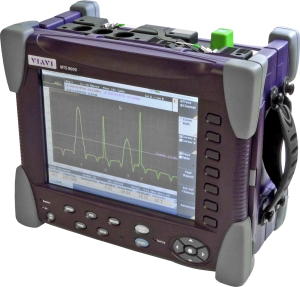
A handheld optical channel checker is a compact, simple, and low-cost option for installation, maintenance, and troubleshooting of xWDM links which do not require OSNR measurements. Typically, they offer the basic bar graph display to show channel presence and power. The SmartClass OCC-55 channel checker measures up to 18 channels for reliable CWDM characterization, while the SmartClass OCC-56 is dedicated to DWDM analysis. The more advanced COSA-4055 (for CWDM) and OCC-4056C (for DWDM) channel checker modules provide more capabilities that include a spectral trace, wavelength offset and power drift measurement, plus a SFP/SFP+ bay to tune and verify pluggable optics. Both intuitively support the installation and maintenance of metro/access, fiber deep, and 5G DWDM applications.
Optical spectrum analyzer modules from VIAVI for manufacturing and development are designed to address unique customer requirements for test applications, optical precision, and speed. As part of the versatile Multiple Application Platform (MAP) for scalable and configurable optical testing, the ultra-compact, high-resolution mHROSA module and high speed mOSA-C1 module bring unsurpassed simplicity and versatility to emerging optical test and manufacturing environments.
Brochures
White Papers & Books
Support at Every Step
We provide support, services, comprehensive training and the resources you need. It’s all part of what we do to maximize the value of your VIAVI investment.
Ask an Expert
Contact us for more information or to receive a price quote. We have the experts to give you the right answer on any of your questions.

